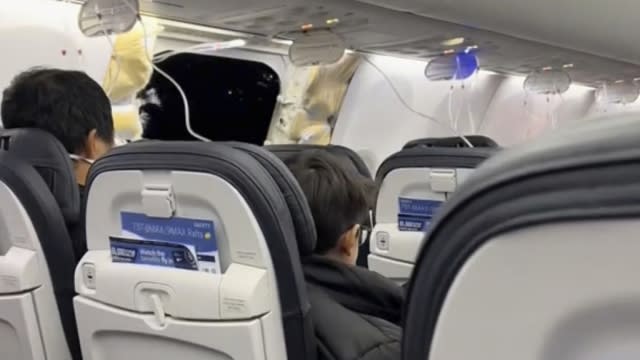3 infants unsecured during mid-air scare, NTSB chair says

Amid the chaos on board an Alaska Airlines flight Friday after a section of the plane broke away, flight attendants had to scurry through the aisles to assist the numerous children on board.
According to the National Transportation Safety Board, three infants on the flight didn't have a seat of their own. Additionally, four unaccompanied minors were among the 171 passengers.
The NTSB, the Federal Aviation Administration and the Association of Flight Attendants-CWA all have recommended that infants have their own seat and be in a car seat during a flight.
"The safest place for your child under the age of two on a U.S. airplane is in an approved child restraint system or device, not in your lap. Your arms aren't capable of holding your in-lap child securely, especially during unexpected turbulence, which is the No. 1 cause of pediatric injuries on an airplane," the FAA said.
SEE MORE: Missing plane segment found, crew 'heroic' during midair scare
But regulators allow children under age 2 to sit in a parent's lap.
Flight attendants have long said that all passengers should be required to have a seat of their own. The Association of Flight Attendants noted the 1989 death of Evan Tsao, who was on board United Flight 232, which crash-landed in Iowa. Tsao was 22 months old at the time and did not have a seat of his own when the plane crashed.
"America's aviation system is the safest and most secure in the world, but there are still many dangers for unsecured children," the Association of Flight Attendants-CWA said. "Simple accidents like falling from a parent's lap pose real risk. Our aviation system is also seeing a steep rise in extreme turbulence, which can lead to tragedy for any passenger who isn't properly secured, but is especially dangerous for infants and toddlers. Flight attendants are critical to passenger safety, especially in the event of an emergency."
This danger became evident on Friday as the air got sucked out of Alaska Airlines Flight 1282 after a refrigerator-sized door plug broke free from the plane. The hole prompted passengers to place oxygen masks over their faces.
SEE MORE: FAA grounds Boeing 737 Max 9 after plane wall detached midair
That meant parents had to not only place an oxygen mask on the children, they had to keep them secure as air rushed through the cabin.
"If you think about what is being told to passengers by the flight attendants during a safety briefing, please secure all of your loose items, put bags under the seats during takeoff, during landing," NTSB Chair Jennifer Homendy said, "that's for safety so things don't move around. The folks we should be most focused on, other than those around the cabin, are our most precious children, so we would urge passengers to put their children under 2 in their own seat, in an FAA-approved car seat, so that they are secure and that they are safe in case something like this happens."
The NTSB has said in the past that unsecured children have died in survivable accidents because they did not have a proper seat.
"Adults may not be able to maintain a secure hold on a lap-held child during turbulence and survivable accidents," the NTSB said. "Preventable deaths and injuries have occurred in children under age 2 who were unrestrained."
Despite the urging of flight attendants, there haven't been any serious attempts in recent years to pass legislation to require passengers to purchase a separate seat for children under age 2. So, for now, all regulators can do is educate parents about the risks of holding an infant during a flight instead of keeping them secured in a seat.
